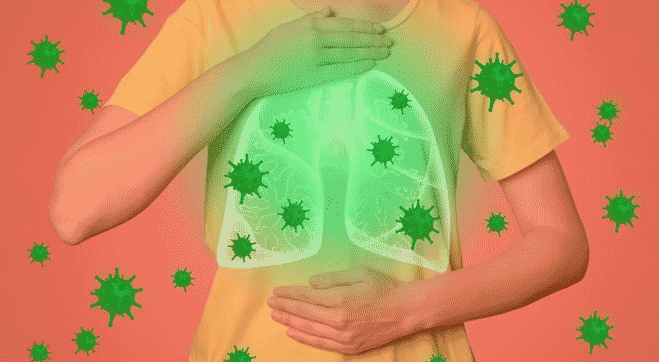Tuberculosis is primarily a disease of the lungs but, can as well affect other parts of the body. In addition to pulmonary tuberculosis the lesser known form of the disease affecting myriad of organs in the body is called extrapulmonary tuberculosis (EPTB).The manifestations start to appear as the pathogen spreads to regions beyond the lungs. In India, between 15 to 20% of all TB cases are EPTB in immunocompetent individuals while 50% of HIV infected patients have extrapulmonary complications.
How serious is Tuberculosis?
Tuberculosis is an airborne infection caused by the bacteria Mycobacterium tuberculosis (MTB). It is
transmitted through droplet nuclei that contain the bacteria, emitted by patients suffering from active
pulmonary TB and is symptomized by
- persistent coughs
- unexplained weight loss
- coughing out bloodor mucus
- fever
- night sweats
When TB is classified on the basis of clinical manifestations; it can be described as Pulmonary TB or extrapulmonary tuberculosis.
How extrapulmonary tuberculosis is different from pulmonary TB?
In pulmonary TB, the pathogenesis begins when the bacilli reach pulmonary alveoli and begin to replicate
within the macrophages that are localized there. Patients with pulmonary TB may be asymptotic, or may
suffer from mild or progressive dry cough, or else may manifest other multiple symptoms.
The initiation of extrapulmonary tuberculosis occurs when the bacilli gain access to other regions of the body through blood or the lymphatic system; as the lung is the primary site of infection. It is more difficult to diagnose as the symptoms mimic those of pulmonary TB and further site specific indications could easily be attributable to other reasons. extrapulmonary tuberculosis may present with the constitutional symptoms of
- fever
- anorexia
- unexpected weight loss
- malaise
- fatigue
Additional symptoms are dependent on the organ and system affected. The most common forms of extrapulmonary tuberculosis include the involvement of lymphatic system, pleura, bones and joints.
What are the different organs affected by extrapulmonary tuberculosis?
- Lymph node tuberculosis
- Tuberculous pleural effusion
- Abdominal tuberculosis
- Neurological tuberculosis (NTB)
Tuberculosis affecting the lymph nodes are the most common form of extrapulmonary tuberculosis seen in India, and can be considered as the local presentation of a systemic disease. It occurs when the bacteria enters through the respiratory tract and spreads to the lymphatic system, with initial involvement of hilar and mediastinal lymph nodes. It manifests as enlarged lymph nodes, and sometimes as cough and dysphagia as well.
Pleural effusion is the build-up of fluid in the lungs and the presence of inflammatory cells in the pleural space. It is one of the most common forms of extrapulmonary tuberculosis, more predominant in men, and manifests as fever, cough and chest pain.
It affect organs like liver, spleen and pancreas. Hepatobiliary and pancreatic TB are seen more often in immunocompromised persons and manifests as anorexia, malaise, low grade fever, night sweats and obstructive jaundice. Splenomegaly is seen more commonly in patients with disseminated tuberculosis
It comprises of tuberculosis meningitis (the most common type), tuberculoma, and arachnoiditis. This condition occurs secondary to tuberculosis in other places in the body and is characterized by inflammatory meningeal exudate, ependymitis, vasculitis, encephalitis, as well as disturbances in cerebrospinal fluid circulation and absorption.
Other forms of extrapulmonary tuberculosis includes pericardial TB, joint and bone tuberculosis, genitourinary tuberculosis, female genital tuberculosis, tuberculosis of larynx, etc.
Can extrapulmonary tuberculosis be diagnosed accurately?
Diagnosis of extrapulmonary tuberculosis with high accuracy depends on the type of approach employed for detecting mycobacteria.
These approaches can be direct or indirect based upon the method employed. Different methods used are.
- HIV testing is recommended to patients with TB since immunosuppression increases susceptibility to extrapulmonary tuberculosis.
- Accessible tissue (such as peripheral lymph node in case of lymph node tuberculosis, or cerebrospinal fluid for neurological tuberculosis) for analysis can be procured for histopathological, cytopathological and microbiological diagnosis.
- Ultrasound scan, Computed Tomography (PET-CT Scan), and Magnetic Resonance Imaging (MRI) can be used for precise localization of extrapulmonary tuberculosis lesions. MRI and CT scan can be used to demonstrate edema, hydrocephalus, and tuberculomas for diagnosis of central nervous system (CNS) TB.
- In the absence of availability of fluid or tissue, a biopsy or fine needle aspiration cytopathology (FNAC) can be used to assess the tissue. FNAC is recommended for patients with lymph node tuberculosis, while excision biopsy of the peripheral lymph node can be done for confirmation of the diagnosis. Lung involvement is occasionally seen in patients with extrapulmonary tuberculosis, hence sputum smear and culture are recommended to suspected patients. However, the acid fast bacillus (AFB) smear and culture technique gives a low yield of organisms in extrapulmonary samples.
- Tuberculin skin test (TST) as well as IGRA can be recommended in patients with suspected extrapulmonary tuberculosis. Between 70-90% of patients with bone and joint TB tests positive for TST/IGRA.
- Among molecular diagnostic tests, nucleic acid amplification techniques (NAAT) are available that amplify the mycobacterial nucleic acid. One of these include cartridge based NAAT that is specific to TB.
- Polymerase chain reaction (PCR) technique is useful for diagnosis of pleural effusion and lymphadenopathy. Diagnosis can be made by using conventional DNA amplification, nested-PCR, or real-time PCR.
Is extrapulmonary tuberculosis manageable?
Management of extrapulmonary disease matches the drug courses prescribed for pulmonary TB. The commonly
used anti-TB drugs include isoniazid, rifampicin, ethambutol and pyrazinamide, and these are prescribed by the
doctor on six to nine month regimes, unless the infected organism is suspected to be resistant to the first line
drugs.
Therapy regimen may also vary based on the type of tuberculosis. For instance, an extended therapy is pericarditis, and disseminated tuberculosis can also be treated with adjunctive corticosteroids.
Interactions between different anti-TB drugs, especially rifampicin are taken into consideration when prescribed. Rifampicin interacts with other drugs, influencing the pathways that are responsible for the metabolism of other drugs and to achieve therapeutic results, the dosage of the other drug may have to be increased.
Surgery can also be required in individuals suffering from extrapulmonary tuberculosis, mostly because of diagnostic purposes (biopsies) and in some cases as therapeutic options because of certain complications or sequelae arising from the disease.
Doctor’s prescriptions and medications are only one half of disease management as without strict patient adherence to the treatments prescribed, further complications are bound to arise. Being aware of the complications associated with a disease and getting timely diagnosis for it are important aspects of disease prevention and management.








